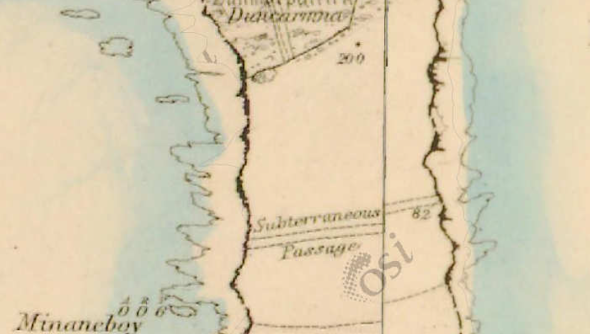The wreck of the Adelaide off the Old Head of Kinsale
The Old Head of Kinsale c1906 from the CIL collection in the National Library
This post, which admittedly is more about the wreck than the lighthouse, is culled from the Cork Examiner 13th February 1862. The tail end of the story was mentioned in the Edward Lezarde post.
The sloop Adelaide left Cork for Clonalkilty in January 1862. As journeys went, they'd probably have been better off sending the cargo of fifty-two tons of Indian corn by donkey and cart. For a start, they were wind-bound near Crosshaven for two weeks and then somehow found themselves trying to ride out a storm when they were off the Old Head of Kinsale. Unfortunately, they lost both their jib and a young member of the crew in the storm and tried to put into the bay on the east side of the Head. It was dusk and she was being drawn inexorably, by waves and a stiff south-easterly wind towards the perpendicular cliff face, two hundred feet high.
As night fell, the lightkeepers saw her no more. When morning came, the coastguards and fishermen scoured the coastline but there was no sign of her. After three days, it was agreed that the sloop must have foundered in the heavy seas and had sunk to the bottom with all hands.
But the Adelaide had not sunk.
At the narrowest point of the isthmus, roughly below where the entrance to the golf course now lies, there is a tunnel, or a 'subterranean passage' as the Ordnance Survey calls it, roughly two hundred yards long, leading from one side of the Old Head to the other. Whether by luck, or incredible seamanship, or a combination of the two, the Adelaide entered the tunnel heading east to west. (There are actually a number of tunnels beneath the isthmus) Not for nothing is the surrounding bay called Holeopen Bay.
The only people left on board by this stage were the Captain, John Mahony and a seaman named Driscoll and when they got roughly halfway through the tunnel, the boat became wedged between the walls and the roof and wouldn't budge.
Caves and tunnels beneath the isthmus. Looking north towards the mainland. Photo Tourism Ireland
After two nights spent in this fearful position, they decided they would have to leave the sloop where it was and make their escape themselves. They were both cold, hungry, thirsty and exhausted. Placing two pieces of timber side by side as a makeshift raft, they clambered on and made for the western end of the tunnel. Almost immediately, an exhausted Driscoll fell in and, though pulled out immediately by the captain, died shortly afterwards.
By now, Mahony could see himself going the same way. His arms and legs were beginning to lose all sensation and he felt he had to move or die. Half swimming, half wading in the dark, he somehow made it to the western side of the headland, where he spent a third night in a dreadful condition.
His only consolation was the place he had reached had cliffs not quite so high as at other places. After a wretched third night at the foot of the cliff, he started climbing in the morning, summoning what remaining strength he had to reach level ground above. Bruised, wounded, not having eaten, drunk or slept for days, he was eventually discovered by the keeper, Edward Lezard, who took him home and, with the help of his wife Mary, nursed him back to health.
The Old Head today








I hope he got a medal at least.
ReplyDeleteMy problem is I'm a nasty, suspicious sort of a person and I'm always distrustful of narratives from the only surviving member of a catastrophe!!!
Delete